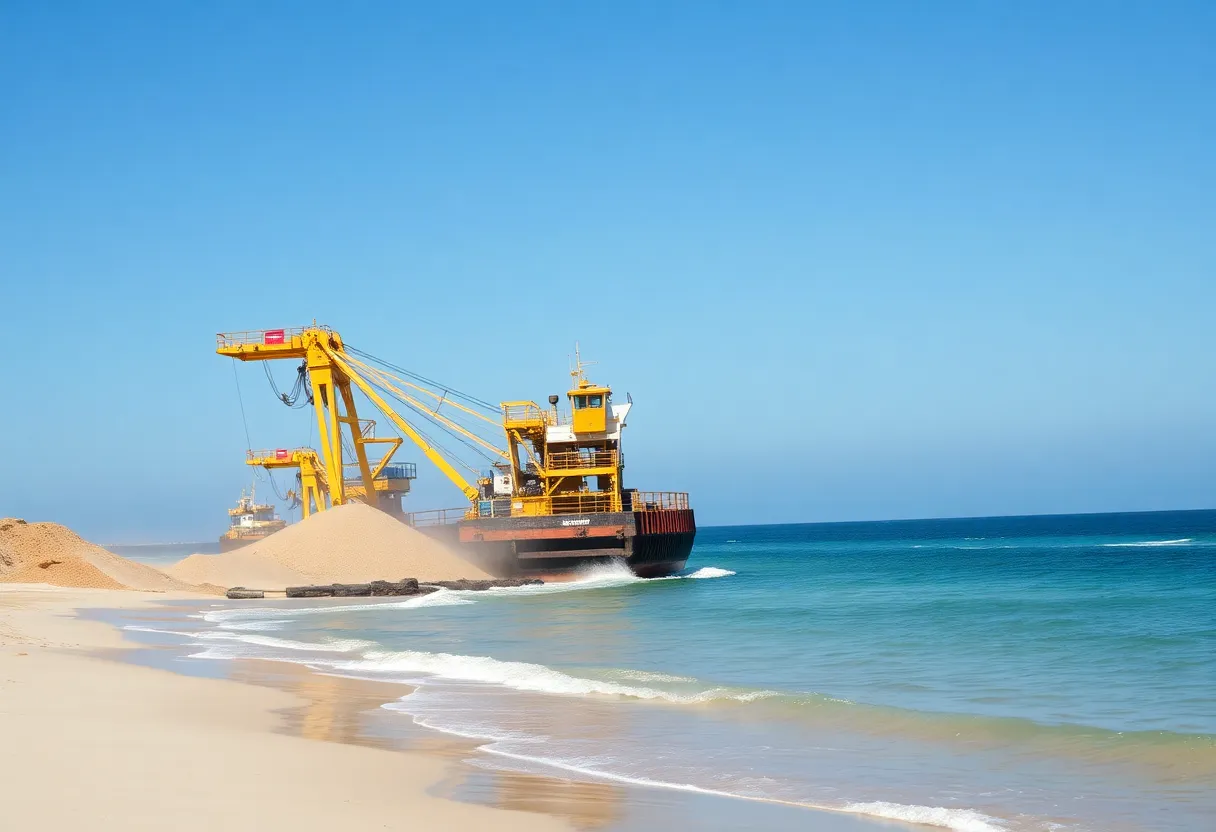News Summary
Southern California agencies are debating the purchase of an ocean-going hopper dredge to combat ongoing beach erosion along the coastline. San Diego County planners are leading this initiative, which is crucial for large-scale sand replenishment efforts. Although the acquisition of a dredge can be costly and complex, experts believe it is vital for maintaining local beaches. Meanwhile, Long Beach has gained approval for a decade-long dredging project to help with beach replenishment, highlighting the urgency of addressing this environmental challenge.
San Diego, California – Southern California agencies are considering the purchase of an ocean-going hopper dredge to address ongoing beach erosion problems affecting the region’s coastline. This move aims to enhance shoreline replenishment efforts that are vital for maintaining the health and accessibility of local beaches.
San Diego County regional planners are at the forefront of discussions regarding the potential acquisition of a hopper dredge, a critical component for large-scale sand replenishment projects. Acquiring and scheduling access to a dredge is noted as one of the most expensive and time-consuming aspects of these initiatives. Currently, most hopper dredges are privately owned and predominantly located on the East Coast, a region with more navigable rivers and harbors compared to the West Coast.
Experts have acknowledged that there has been substantial dialogue among local agencies concerning the dredge purchase. The operation of a hopper dredge requires a dedicated crew of approximately 17 people working full-time. While effective, these dredges consume a significant amount of fuel—between 5,000 to 10,000 gallons daily—and their emissions must adhere to California air quality standards. Additionally, operations with these dredges are often limited to certain periods to protect endangered species during their nesting and spawning seasons.
The financial implications of acquiring a dredge are considerable, as the purchase represents at least 25% of the overall costs for sand replenishment projects. Furthermore, constructing a new dredge can take up to two years and cost between $150 million and $250 million. The logistical challenges do not end with the purchase; dredging operations also require extensive pipelines for transporting sand, which must be assembled and disassembled at each job site.
Currently, the U.S. Army Corps of Engineers is the only government entity owning hopper dredges, with a total of four situated across both coasts (two on the West Coast and two on the East Coast). However, these dredges typically remain in their respective coastal regions unless there is an urgent need that necessitates a transfer, which can be costly and time-consuming. As a result, many Southern California projects tend to rely on smaller cutter dredges or clamshell dredges that work within harbors or lagoons, rather than the ocean-going hopper dredges capable of pulling sand from depths greater than 30 feet.
Most sand replenished on the beaches of San Diego County is sourced from lagoons, harbors, and rivers, with large-scale sand projects occurring infrequently. The idea of investing in a dredge was raised alongside the San Diego Association of Governments (SANDAG) plans for a new regional sand replenishment initiative. Previous projects coordinated by SANDAG that utilized hopper dredges have successfully deposited significant quantities of sand on local shores.
Despite the potential benefits, members of SANDAG’s shoreline preservation group have expressed concerns over the practicality of owning a dredge. Some members have highlighted the costs and complexities involved, contesting the necessity of such a purchase after reviewing expert insights on the subject.
In related developments, Long Beach has recently secured approval for a 10-year dredging project aimed at channel maintenance and beach replenishment, which involves the annual removal of up to 150,000 cubic yards of sediment from various locations. The material dredged from these efforts will either be used for beach nourishment or disposed of at an Environmental Protection Agency (EPA)-approved site, depending on its suitability for replenishing local shores. Long Beach’s proactive approach illustrates a long-standing commitment to dredging projects, as they have been undertaking similar initiatives for over 30 years. The new approval is expected to provide a more extended maintenance cycle going forward.
Deeper Dive: News & Info About This Topic
HERE Resources
Additional Resources
- San Diego Union-Tribune: A Dredge Is Critical for Region’s Sand Replenishment Efforts
- Wikipedia: Dredging
- Press-Telegram: Coastal Commission Approves Long Beach’s 10-Year Dredging Project
- Google Search: dredging projects
- Dredging Today: San Dieguito Lagoon Dredging Kicks Off
- Google Scholar: dredging environmental impact
- Wiley Online Library: Dredging and Environmental Effects
- Encyclopedia Britannica: Dredging
- Los Angeles Times: Dredge Pier
- Google News: sand replenishment

Author: STAFF HERE SAN DIEGO WRITER
The SAN DIEGO STAFF WRITER represents the experienced team at HERESanDiego.com, your go-to source for actionable local news and information in San Diego, San Diego County, and beyond. Specializing in "news you can use," we cover essential topics like product reviews for personal and business needs, local business directories, politics, real estate trends, neighborhood insights, and state news affecting the area—with deep expertise drawn from years of dedicated reporting and strong community input, including local press releases and business updates. We deliver top reporting on high-value events such as Comic-Con International, San Diego County Fair, and San Diego Pride Festival. Our coverage extends to key organizations like the San Diego Regional Chamber of Commerce and United Way of San Diego County, plus leading businesses in biotechnology, healthcare, and technology that power the local economy such as Qualcomm, Illumina, and Scripps Health. As part of the broader HERE network, including HEREAnaheim.com, HEREBeverlyHills.com, HERECostaMesa.com, HERECoronado.com, HEREHollywood.com, HEREHuntingtonBeach.com, HERELongBeach.com, HERELosAngeles.com, HEREMissionViejo.com, and HERESantaAna.com, we provide comprehensive, credible insights into California's dynamic landscape.





